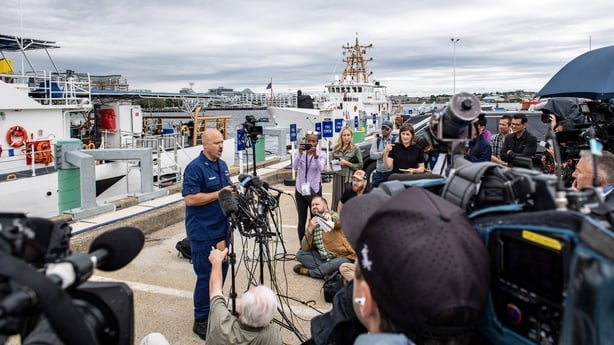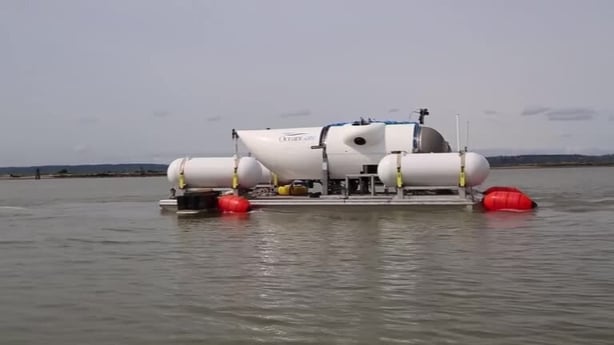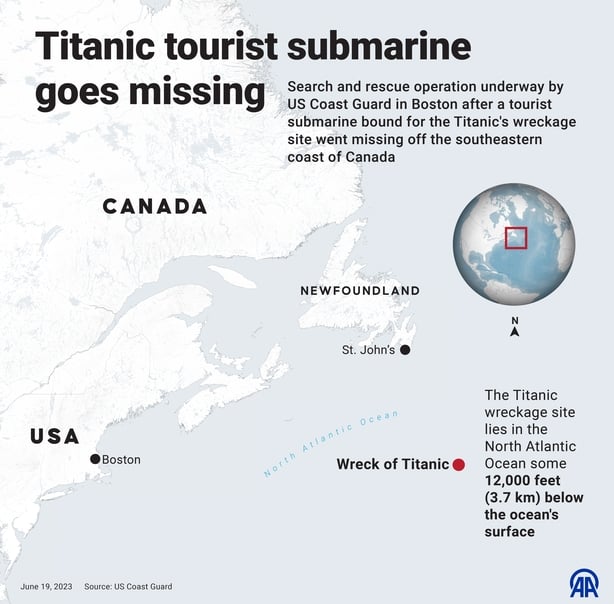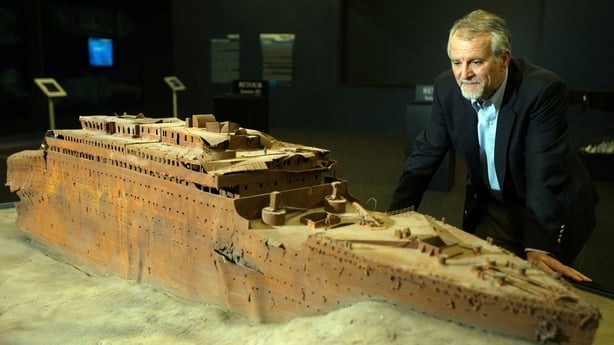The five people inside a tourist submersible that went missing during a dive to the wreck of the Titanic have less than 40 hours of breathable air left, the US Coast Guard has said.
Captain Jamie Frederick of the US Coast Guard told reporters in Boston that air and ship rescue efforts near the site in the North Atlantic "have not yielded any results".
Rescuers are scouring thousands of square miles in the remote North Atlantic in a race against time to find the missing submersible.
It disappeared on Sunday while taking wealthy tourists to see the wreckage of the doomed liner.
The 6.5 metre Titan submersible has the capacity to stay underwater for 96 hours, according to its specifications.
That gives the five men aboard until early on Thursday before air runs out.
One pilot and four passengers were inside the submersible early on Sunday when it lost communication with a ship on the surface about an hour and 45 minutes into its dive.
The Titanic site is about 1,450km east of Cape Cod and 644km south of St John's, Newfoundland.
US and Canadian aircraft have searched about 7,600 square miles, larger than the state of Connecticut, Captain Frederick told reporters.
The Canadian military has dropped sonar buoys to listen for any sounds that might be coming from the Titan, with no results thus far.
A commercial vessel with an unmanned vehicle capable of deep dives is also assisting, Capt Frederick said.

"There is a ... full-court press effort to get equipment on scene as quickly as we can," he said.
Those aboard the submersible, the highlight of a tourist expedition that costs $250,000 per person, included British billionaire Hamish Harding, 58, and Pakistani-born businessman Shahzada Dawood, 48, with his 19-year-old son Suleman, both British citizens.
The 77-year-old French explorer Paul-Henri Nargeolet and Stockton Rush, founder and CEO of the vessel's US-based operating company OceanGate, were also reported to be on board.
Authorities have not confirmed the identity of any passenger.

Rescuers face significant obstacles both in finding the Titan and in saving the people aboard, according to experts.
If the submersible experienced an emergency in mid-dive, the pilot would likely have released weights to float back to the surface, according to Alistair Greig, a professor of marine engineering at University College London.
But absent communication, locating a van-sized submersible in the vast Atlantic could prove challenging, he said.
The submersible is sealed with bolts from the outside, which means the occupants cannot escape without assistance even if it surfaces.
If the Titan is on the ocean floor, a rescue effort would be even more challenging due to the extreme conditions more than two miles below the surface.
The Titanic lies 3,810 metres underwater, where light does not penetrate. Only specialised equipment can reach those depths without getting crushed by the massive water pressure.

"It's really a bit like being an astronaut going into space," said Tim Matlin, a Titanic expert.
"I think if it's on the seabed, there are so few submarines that are capable of going that deep. And so, therefore, I think it was going to be almost impossible to effect a sub-to-sub rescue."
OceanGate said it was "mobilising all options" to rescue those aboard the Titan.
US Coast Guard Rear Admiral John Mauger told NBC News the company is leading the search efforts with Coast Guard assets brought to the site.
"They know that site better than anybody else," he said. "We're working very closely with them to prioritize our underwater search efforts and get equipment there."
The French government said it will send a ship equipped with a deep-sea diving vessel to help the search-and-rescue operations.
The ship, called the Atalante, is managed by the Ifremer research institute. Ifremer said it had been contacted yesterday by the US Navy with a request for help.
"It carries the Victor 6000 autonomous robot, capable of descending to a depth of 6,000 metres, beyond the 3,800 metres of the wreck's position", Ifremer said, adding the ship was expected to arrive on the site tomorrow evening.
Frenchman Mr Nargeolet, 77, was part of the first expedition to visit the wreck in 1987 and has previously lectured at University College Cork.

OceanGate schedules five week-long "missions" to the Titanic each summer, according to its website.
David Pogue, a CBS reporter, dove to the site on board the Titan last year.
In a December news report, he read aloud the waiver he had to sign, which noted the submersible had "not been approved or certified by any regulatory body" and could result in death.
In an interview today, Mr Pogue said the OceanGate has successfully gone down to the wreck around two dozen times and that the company does a meticulous safety check before each attempt.
"They treat this thing like a space launch," he said. "It is definitely a culture of safety."
Mr Harding, a UAE-based businessman and adventurer who is chairman of Action Aviation, posted a message on Facebook on Saturday, saying: "This mission is likely to be the first and only manned mission to the Titanic in 2023."
Mr Dawood is vice chairman of Engro, one of Pakistan's largest conglomerates with investments ranging from fertilisers and energy to vehicle manufacturing.
Read more:
Titanic tourist submersible craft goes missing on dive to wreck
What are submersibles, how do they communicate?
Rory Golden, an Irish explorer on a support vessel with OceanGate Expeditions, urged the public to avoid speculation, and thanked those offering support.
"The reaction and offers of help globally is truly astonishing, and only goes to show the real goodness in people at a time like this," he wrote in a Facebook post.
The sinking of the Titanic, which killed more than 1,500 people, has been immortalised in books and films, including the 1997 blockbuster movie "Titanic" that renewed popular interest in the wreck.
In order to visit the wreck, passengers climb inside the five-person submersible, which takes two hours to descend approximately 3,800m to the Titanic.
The passenger ship famously sank in 1912 on its maiden voyage after striking an iceberg, killing more than 1,500 people.
The wreckage, which was found in 1985, is in two main pieces and remains a source of fascination and a lure for nautical experts and underwater tourists.
